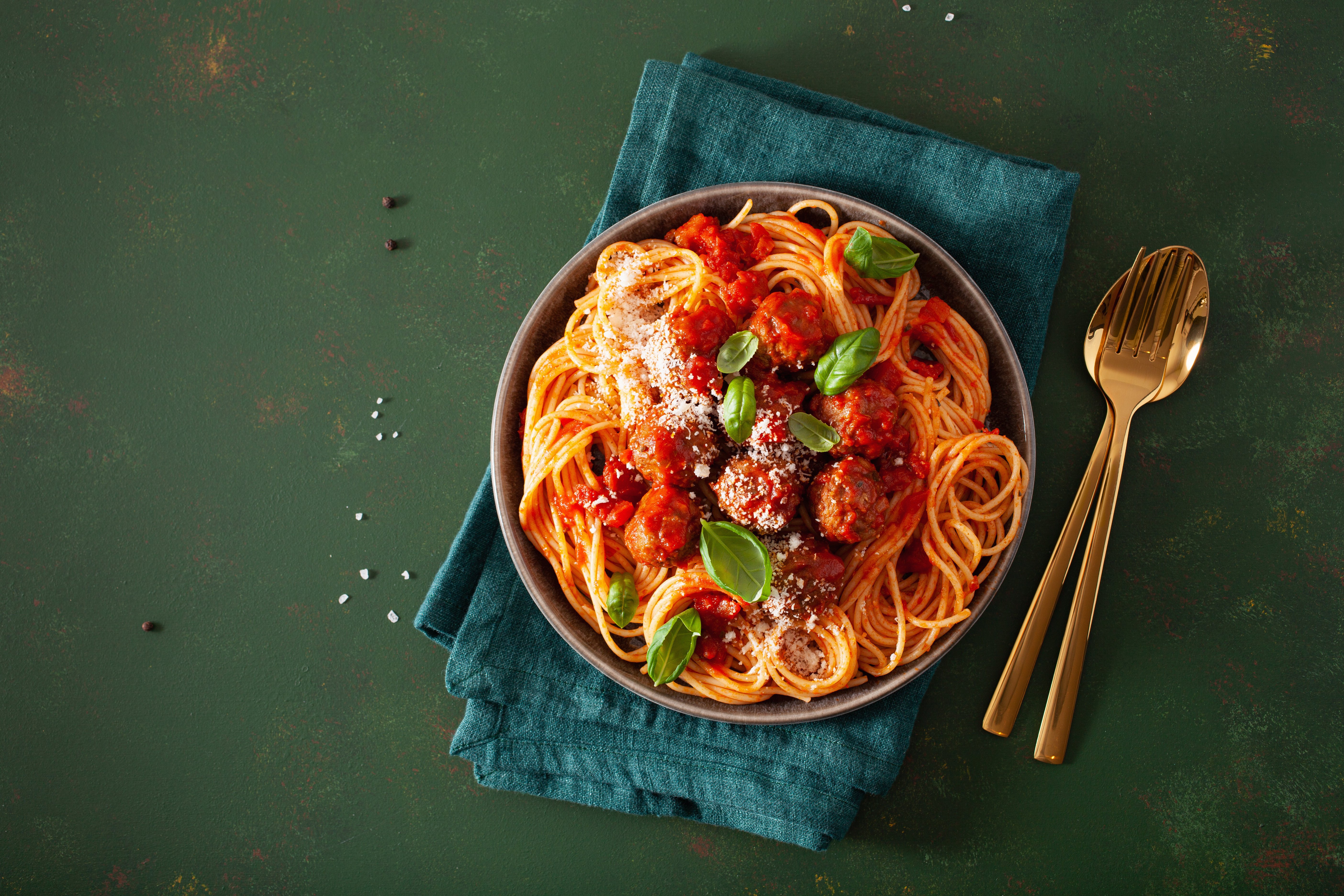What’s on the Menu?
Crafting a menu can be a creative, satisfying task and can result in a mouth-watering experience for your customers!
A well-crafted menu is important because it generates more orders, helps customers form ordering habits, builds a stronger connection to customers by engaging with them at the point of purchase, and last but not least it helps you get organised!
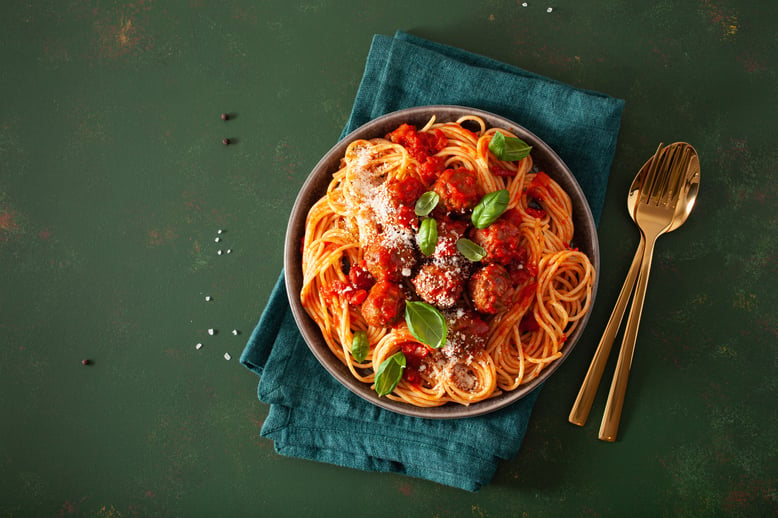
So what is a well-crafted menu?
How do you decide what and how many items you put on the menu? What is going to be most enticing for your customers on any given week? What sizes do you offer for each dish? What are you going to talk about in your menu email? We cover all these topics in this resource.
Deciding what to put on your Menu
Your weekly menu should present a manageable selection of curated items that are available to order until the menu closes. Because you are operating on a batch model, you can literally put anything on your menu – you don’t have to make it unless it sells. Ideally however, you want to put items on the menu that will sell! So let’s have a look at what we know…
Offer what your customers need
Over time you will understand what your customers are looking for, but typically, customers buying meals from cooks using the Cookaborough platform are looking to solve the eternal dinner dilemma – typically they want food that will be freshly made, with healthy options, that they feel good about feeding to the family (or themselves).
So whatever your style may be, we have great insights as to the kinds of meals that attract ongoing sales. The dishes that have generated the most sales from all the food businesses that are using the platform are… drum roll…
- Lasagnes (smalls and large)
- Chicken, lamb, vegetable curries, slow cooks and tagines (large)
- Pies (large)
- Meatballs (large)
- Soups (seasonally, small and large sizes)
- Salads, especially vibrant healthy vegetable versions, but also those including meat like fragrant vietnamese chicken salads or fish such as salmon and soba noodle and veg salad (seasonally, smalls and large sizes)
So this tells you that it would be good to have at least one of these types of meals on your menu every week. If you are a vegan business, a vegan lasagne might be a good idea. If you are a specialty cuisine, maybe looking at doing your very own version of these types of dishes will make sure there is something that your customers will find not only delicious but be helping them with their weekly challenge.
Keep it ‘fresh’
We recommend a menu that changes every week, always giving your customers something new to consider and a reason to dive into your menu every week.
If your menu doesn’t change much week in week out, customers tend to assume what is on offer and make a decision whether or not to order without even checking out your menu. The idea is you want them clicking through to your menu to see your wonderful creations.
Sometimes you may have only one or two fresh additions to your menu. You can create a new section heading for these in Recipes so they appear at the beginning of your menu.
Once your recipes are on the platform it’s super easy to change up your menu week on week. And then all that remains is sharing your reasons and inspiration behind the Menu with your customers. You do this in your Menu Description and the Menu Open email to really connect with your customers on what the idea was behind your menu choice that week.
Fresh vs frozen meals
Talking about keeping it fresh, we often are asked whether it’s OK to put frozen meals on the menu. Frozen meals are definitely OK to put on the menu!
Many chefs have been conflicted over the potentially more convenient and cost-effective benefits that they offer. But if you snap-freeze your meals, they tend to be just as nutritious as freshly cooked ones, without losing any texture quality on reheating. From your customer’s point of view, there is more willingness to try frozen meals, due to greater understanding that frozen meals are not what they used to be, but instead are often just as nutritious as fresh, and no longer having to add unnecessary amounts of sodium or preservatives.
C Si Bon is a great example of how to sell frozen meals. All the meals Natasha has on her menu are frozen. She describes her business as “Restaurant quality food at home, made fresh and then snap frozen with no hidden nasties”.
As you can see, Natasha makes no apology as to her meals being frozen. How you describe your meals, whether they are fresh or frozen, can make the difference between a customer feeling good about purchasing your food, or a customer making an assumption about your food and possibly being unwilling to try it. Describe your meals in Recipes, and then in the Menu Opening email, and the Menu Description text within Menus.
TIP: We know that customers tend on average to purchase 4-5 items every week. This would imply that at least one of those items would be popped in their freezer for another night. So putting freezer-friendly items on the menu is a good idea.
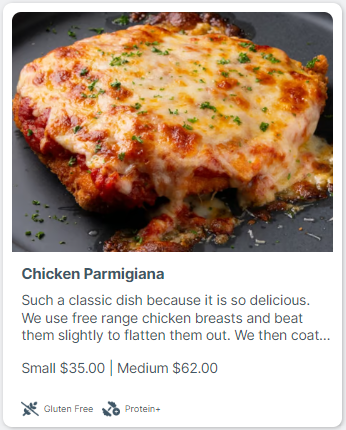
What sizes and prices to offer?
You are probably catering for busy families, which means that you are offering large sizes of dishes. But offering smaller sizes is a good idea as well - - sometimes customers will order small sizes because they:
- Live alone or with only one other
- Are buying food for a loved one who lives alone
- Are a Home Care Package participant
- Are thinking ahead to make sure they have healthy weekday lunches
- Are making sure older children in the house always have food at hand in the fridge
So if you are able to offer small sizes in some types of meals it’s a great idea.
Generally, repeat customers get into the habit of spending a set amount per week on your meals. Offering various sizes and prices also allows your customers to manage their needs more fluidly and gives them options for how to spend their budget if one week they find their needs changing slightly.
FUN FACT: 1 in 4 Australian households are single person households [Australian Institute of Family Studies] and facing the increasingly costly dinner dilemma of preparing and cooking for one, every evening.
Showcase your food
Your Menu is where all the effort you’ve put into your Recipes comes to life. The images, dietary information and descriptions of each item come into full view once on your menu.
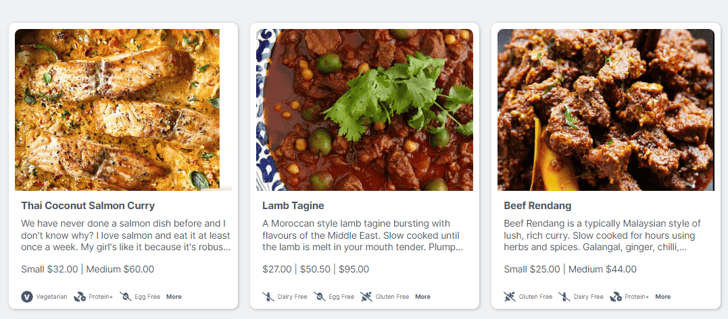
So make your menu look beautiful with plated images of your meals, rather than pictures of the containers they arrive in, or indeed no image at all. You want your customer to imagine themselves eating the dish as if they have cooked it themselves.
For more tips on food photography read here and here.
Additionally, if you have a lot of items on your menu, make it easy to navigate with Menu Sections.
Dietary icons should be visible, and linked items that “go well with” the dishes you have on the menu should also be available.
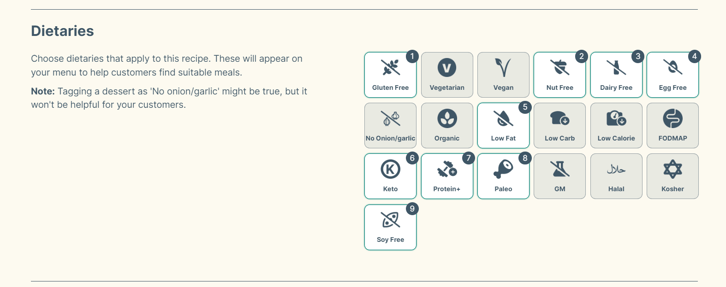
So if you preview your menu and it’s neither of these things, head back to Recipes and upload a new picture, add Menu Sections to make it easier for your customers to find what they are looking for and link items to other items to remind customers of what else there is on the menu!
TIP: If you have only a few items on your menu it tends to look better without Section headings.
Get the timing right
For customers: Weekday deliveries and pickups are the most popular choice for customers, with Tuesday being ideal.
For you: Plan how much notice you need to fulfil orders, which days you will cook, and when you can deliver. Then your weekly rhythm can be worked out.
Read more about your weekly rhythm here.
Make sure to feed your passion!
There’s no point running your own business without there being some joy in the mix. So whatever your passion is, be sure to let it shine somewhere on the menu. If your passion is trying out new dishes, do it! Remember that the nature of cooking by batch once a week to fulfil pre-ordered meals means that you can put literally anything you like on a menu to try it out - if it doesn’t sell, you don’t have to make it!Let us know how you go
This guide is dedicated to ideas and suggestions we’ve seen work with great effect. We would love to hear what works for you and if you have your own ideas that you would like to share. Our team would love to hear from you.
FUN FACT: The ideal way to buy the most nutritious food is via farmers markets - the food needs to be locally produced which means it is seasonally appropriate, has been harvested ripe and has not travelled far to reach the end consumer – it also does not nee to be packaged in plastic. But when this is not feasible, using frozen produce to make your meals may sometimes be a good alternative – typically, frozen fruit and vegetables are harvested at peak ripeness which means they can be more nutritious than fruit and vegetables that have been harvested unripe to allow for miles of travel before reaching the end destination.
Need more help?
Online: Check out the 'Learn' tab on the Cookaborough home page for more tips, tricks and insights.
Email: If you have further questions or need assistance, contact our team.
